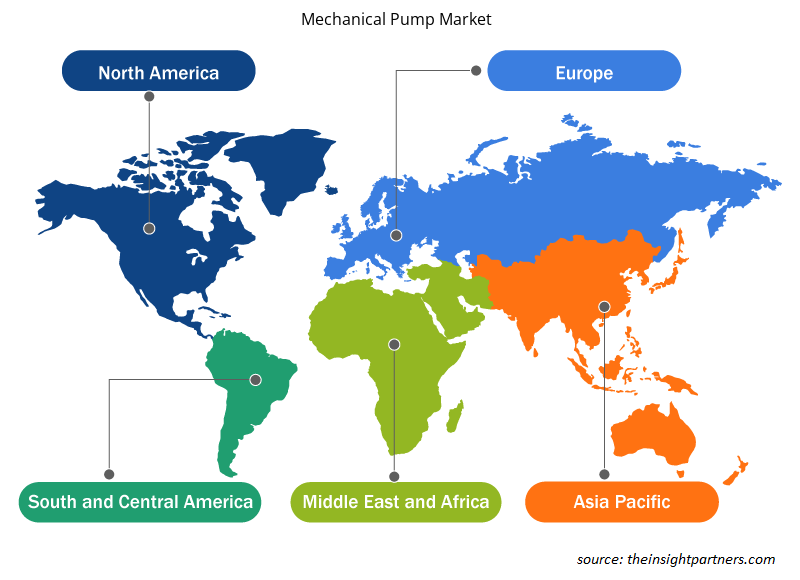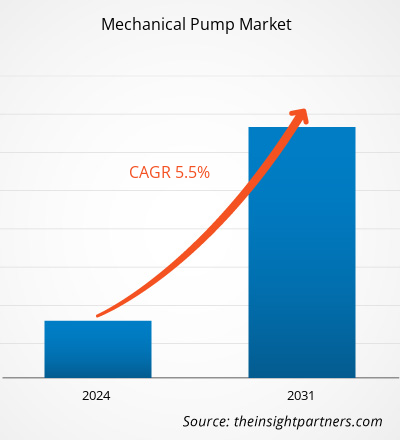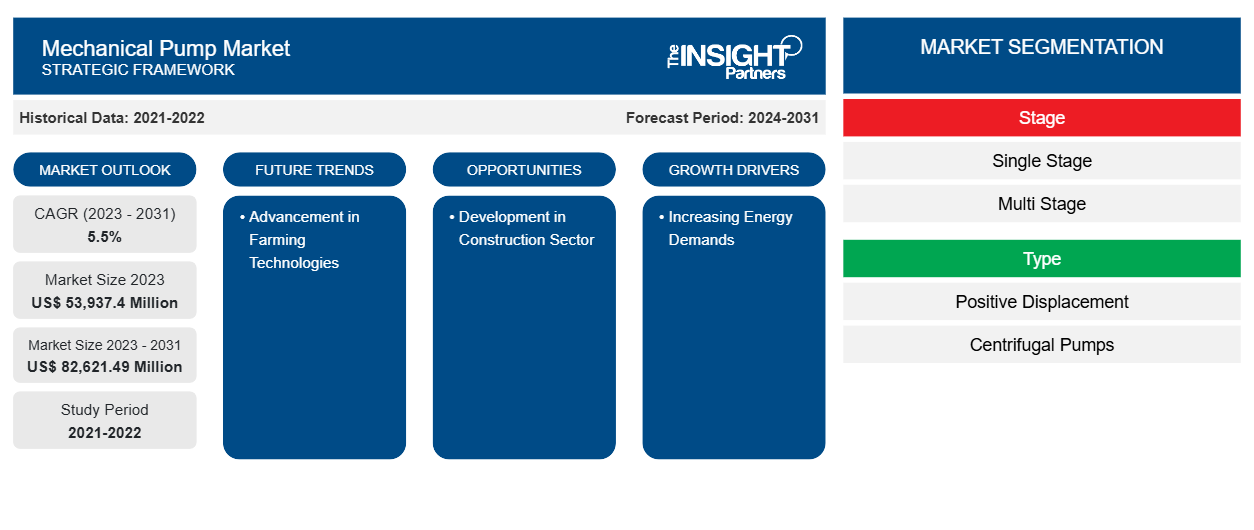Se proyecta que el tamaño del mercado de bombas mecánicas alcance los 82.621,49 millones de dólares estadounidenses en 2031, frente a los 53.937,4 millones de dólares estadounidenses en 2023. Se espera que el mercado registre una CAGR del 5,5 % durante el período 2023-2031. Es probable que el creciente avance en las tecnologías agrícolas siga siendo una tendencia clave en el mercado.
Análisis del mercado de bombas mecánicas
Algunas de estas partes interesadas del mercado de bombas mecánicas incluyen agencias gubernamentales, asociaciones industriales y organismos reguladores, entre otros, como la Asociación de Fabricantes de Bombas de la India (IPMA), la Asociación de Fabricantes de Bombas Británicas (BPMA), Europump (la Asociación Europea de Fabricantes de Bombas) y el Instituto Hidráulico (HI), entre otros. Los usuarios finales de bombas mecánicas incluyen industrias como la química, el petróleo y el gas , la petroquímica, la minería, la generación de energía, la automoción, la agricultura, la calefacción, la ventilación y el aire acondicionado y la gestión de aguas residuales, entre otras.
Descripción general del mercado de bombas mecánicas
Los actores clave en el ecosistema del mercado global de bombas mecánicas incluyen fabricantes de bombas mecánicas, agencias gubernamentales, asociaciones industriales, organismos reguladores, proveedores/distribuidores y usuarios finales. Algunos de los principales fabricantes de bombas mecánicas incluidos en este informe son Grundfos Holding A/S, Kirloskar Brothers Limited, KSB SE & Co. KGaA, Ebara Corporation, Sulzer Ltd, Pleuger Industries, The Weir Group PLC, Wilo SE, Tsurumi Manufacturing Co., Ltd. y Xylem Inc., entre muchos otros. Además de estos actores clave del ecosistema, varios actores periféricos en el mercado global de bombas mecánicas desempeñan un papel vital a la hora de permitir la adopción de estas máquinas entre los usuarios finales y promover los avances tecnológicos para el crecimiento futuro sostenible del mercado.
Personalice este informe según sus necesidades
Obtendrá personalización en cualquier informe, sin cargo, incluidas partes de este informe o análisis a nivel de país, paquete de datos de Excel, así como también grandes ofertas y descuentos para empresas emergentes y universidades.
-
Obtenga las principales tendencias clave del mercado de este informe.Esta muestra GRATUITA incluirá análisis de datos, desde tendencias del mercado hasta estimaciones y pronósticos.
Impulsores y oportunidades del mercado de bombas mecánicas
Las crecientes demandas energéticas de los actores del mercado favorecen el mercado
La creciente demanda de energía y la necesidad de un suministro de energía ininterrumpido en los sectores comercial e industrial están impulsando la demanda de infraestructura energética adicional. El agua desempeña un papel fundamental en la generación de electricidad en estas plantas, ya que se convierte en vapor para impulsar las turbinas. Se utilizan bombas mecánicas para hacer circular el agua en estas plantas de energía. Debido al aumento de la población, la industrialización y la urbanización a nivel mundial, especialmente en Asia Pacífico, la demanda de energía está aumentando a un ritmo elevado. Como resultado, se están instalando varias plantas de energía alimentadas con combustibles fósiles en todo el mundo. Además, la generación de energía a partir de fuentes de energía renovables se encuentra en una etapa incipiente y se está enfatizando principalmente en América del Norte y Europa. Por lo tanto, la creciente demanda de energía, y en consecuencia la escalada de las actividades de generación de energía, está impulsando el crecimiento del mercado de bombas mecánicas.
Desarrollo en el sector de la construcción
Varios actores extranjeros están reubicando sus operaciones de fabricación en países en desarrollo en APAC para aprovechar los beneficios de los bajos costos laborales, lo que se proyecta que impulsará aún más la construcción industrial. Por lo tanto, con el aumento constante de las actividades de construcción en todo el mundo, se espera que el mercado de bombas mecánicas crezca aún más durante el período de pronóstico. El crecimiento de este sector se atribuye principalmente al aumento de la población urbana, respaldado por un aumento en el nivel de vida. Además, el aumento de la construcción comercial, como centros recreativos, salas de cine, centros comerciales, hospitales, estadios deportivos y edificios de oficinas, está impulsando aún más la proliferación de este sector. Las economías emergentes están tomando varias iniciativas para impulsar la industrialización mediante la creación de entornos comerciales favorables para los inversores internacionales, junto con la ampliación del apoyo al crecimiento de la fabricación local, lo que se proyecta que impulsará la demanda de bombas mecánicas durante el período de pronóstico.
Informe de mercado de bombas mecánicas Análisis de segmentación
Los segmentos clave que contribuyeron a la derivación del análisis del mercado de bombas mecánicas son la etapa, el tipo y la aplicación.
- Según la etapa, el mercado de bombas mecánicas se divide en monoetapa y multietapa. El segmento monoetapa tuvo una mayor participación de mercado en 2023.
- Según el tipo, el mercado de bombas mecánicas se divide en bombas de desplazamiento positivo y bombas centrífugas. El segmento de bombas centrífugas tuvo una mayor participación de mercado en 2023.
- Según la aplicación, el mercado de bombas mecánicas se divide en industrial, comercial y residencial. El segmento industrial tuvo una mayor participación de mercado en 2023.
Análisis de la cuota de mercado de bombas mecánicas por geografía
El alcance geográfico del informe del mercado de bombas mecánicas se divide principalmente en cinco regiones: América del Norte, Asia Pacífico, Europa, Medio Oriente y África, y América del Sur y Central.
El alcance del informe del mercado de bombas mecánicas abarca América del Norte (EE. UU., Canadá y México), Europa (Rusia, Reino Unido, Alemania, Francia, Italia y el resto de Europa), Asia Pacífico (Corea del Sur, India, Australia, Japón, China y el resto de Asia Pacífico), Oriente Medio y África (Sudáfrica, Arabia Saudita, Emiratos Árabes Unidos y el resto de Oriente Medio y África) y América del Sur y Central (Argentina, Brasil y el resto de América del Sur y Central). En términos de ingresos, Asia Pacífico dominó la participación de mercado de bombas mecánicas en 2023. América del Norte es el segundo mayor contribuyente al mercado mundial de bombas mecánicas, seguido de Europa.
Perspectivas regionales del mercado de bombas mecánicas
Los analistas de Insight Partners explicaron en detalle las tendencias y los factores regionales que influyen en el mercado de bombas mecánicas durante el período de pronóstico. Esta sección también analiza los segmentos y la geografía del mercado de bombas mecánicas en América del Norte, Europa, Asia Pacífico, Oriente Medio y África, y América del Sur y Central.

- Obtenga datos regionales específicos para el mercado de bombas mecánicas
Alcance del informe de mercado de bombas mecánicas
| Atributo del informe | Detalles |
|---|---|
| Tamaño del mercado en 2023 | US$ 53.937,4 millones |
| Tamaño del mercado en 2031 | US$ 82.621,49 millones |
| CAGR global (2023 - 2031) | 5,5% |
| Datos históricos | 2021-2022 |
| Período de pronóstico | 2024-2031 |
| Segmentos cubiertos |
Por etapa
|
| Regiones y países cubiertos |
América del norte
|
| Líderes del mercado y perfiles de empresas clave |
|
Densidad de actores del mercado de bombas mecánicas: comprensión de su impacto en la dinámica empresarial
El mercado de bombas mecánicas está creciendo rápidamente, impulsado por la creciente demanda de los usuarios finales debido a factores como la evolución de las preferencias de los consumidores, los avances tecnológicos y una mayor conciencia de los beneficios del producto. A medida que aumenta la demanda, las empresas amplían sus ofertas, innovan para satisfacer las necesidades de los consumidores y aprovechan las tendencias emergentes, lo que impulsa aún más el crecimiento del mercado.
La densidad de actores del mercado se refiere a la distribución de las empresas o firmas que operan dentro de un mercado o industria en particular. Indica cuántos competidores (actores del mercado) están presentes en un espacio de mercado determinado en relación con su tamaño o valor total de mercado.
Las principales empresas que operan en el mercado de bombas mecánicas son:
- CORPORACIÓN EBARA
- Grundfos Holding A/S
- Hermanos Kirloskar Limited
- KSB SE & Co. KGaA
- INDUSTRIAS PLEUGER
- Sulzer Ltd
Descargo de responsabilidad : Las empresas enumeradas anteriormente no están clasificadas en ningún orden particular.

- Obtenga una descripción general de los principales actores clave del mercado de bombas mecánicas
Noticias y desarrollos recientes del mercado de bombas mecánicas
El mercado de bombas mecánicas se evalúa mediante la recopilación de datos cualitativos y cuantitativos a partir de una investigación primaria y secundaria, que incluye publicaciones corporativas importantes, datos de asociaciones y bases de datos. A continuación, se enumeran algunos de los avances en el mercado de bombas mecánicas:
- EBARA Corporation Japan (EBARA) ha adquirido el 100 % del capital de Hayward Gordon LP (Hayward Gordon). (Fuente: EBARA Corporation, comunicado de prensa, octubre de 2022)
- Grundfos Holding A/S, líder mundial en soluciones avanzadas de bombeo y tecnología del agua, inauguró hoy su planta de última generación en Serbia. (Fuente Grundfos Holding A/S, comunicado de prensa, septiembre de 2022)
Informe de mercado sobre bombas mecánicas: cobertura y resultados
El informe “Tamaño y pronóstico del mercado de bombas mecánicas (2021-2031)” proporciona un análisis detallado del mercado que cubre las siguientes áreas:
- Tamaño del mercado de bombas mecánicas y pronóstico a nivel global, regional y nacional para todos los segmentos clave del mercado cubiertos bajo el alcance
- Tendencias del mercado de bombas mecánicas, así como dinámicas del mercado, como impulsores, restricciones y oportunidades clave
- Análisis PEST y FODA detallados
- Análisis del mercado de bombas mecánicas que cubre las tendencias clave del mercado, el marco global y regional, los principales actores, las regulaciones y los desarrollos recientes del mercado.
- Panorama de la industria y análisis de la competencia que abarca la concentración del mercado, análisis de mapas de calor, actores destacados y desarrollos recientes para el mercado de bombas mecánicas
- Perfiles detallados de empresas
- Análisis histórico (2 años), año base, pronóstico (7 años) con CAGR
- Análisis PEST y FODA
- Tamaño del mercado, valor/volumen: global, regional y nacional
- Industria y panorama competitivo
- Conjunto de datos de Excel
Informes recientes
Informes relacionados
Testimonios
Razón para comprar
- Toma de decisiones informada
- Comprensión de la dinámica del mercado
- Análisis competitivo
- Información sobre clientes
- Pronósticos del mercado
- Mitigación de riesgos
- Planificación estratégica
- Justificación de la inversión
- Identificación de mercados emergentes
- Mejora de las estrategias de marketing
- Impulso de la eficiencia operativa
- Alineación con las tendencias regulatorias























 Obtenga una muestra gratuita para - Mercado de bombas mecánicas
Obtenga una muestra gratuita para - Mercado de bombas mecánicas